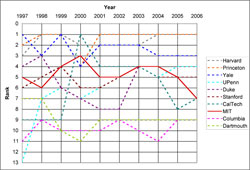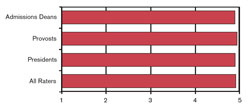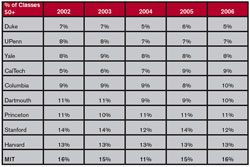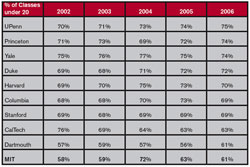
| Vol.
XVIII No.
3 January / February 2006 |
| contents |
| Printable Version |
MIT Rated 7th in Latest U.S. News Ranking
Last year, U.S. News & World Report published its 2006 edition of “America’s Best Colleges.” Among the top PhD-granting institutions, MIT ranked seventh, tied with CalTech.

MIT is consistently in the top group of schools. The chart shows MIT’s ranking for the last 10 years, alongside the rankings of other top schools. MIT’s highest ranking was in 2000, when it ranked third. Its lowest raking came this year. While there are invariably year-to-year fluctuations, the rankings have been largely consistent over time; for the 10 schools in our sample, none fell below 13 over the last decade.
U.S. News uses a weighted average of 16 numerical factors to rank schools. These factors fall into seven broad categories: peer assessment, student selectivity, faculty resources, graduation and retention rate, financial resources, alumni giving, and graduation rate performance. Peer assessment is the largest factor, worth a quarter of the total score. Each year, U.S. News sends surveys to presidents, provosts, and deans of admissions asking them to rate the undergraduate academic programs of peer schools. These ratings range from 1 (marginal) to 5 (distinguished).

(click on image to enlarge)
MIT consistently ranks number one on this measure, often tied with Harvard, Princeton, Stanford, and Yale. The chart presents the 2006 average rating for MIT by type of administrator. While provosts, on average, rate MIT slightly higher than presidents and deans of admissions, the differences are negligible.
Another important factor in the rankings is faculty resources, worth 20% of the total score. Forty percent of this factor is based on undergraduate class size, a proxy for the value an institution places on undergraduate teaching. U.S. News measures class size two ways: the proportion of classes under 20 and the proportion of classes 50 or above. Compared to other top ranked schools, MIT reports the lowest percentage of small classes and the highest percentage of large classes.

(click on image to enlarge)
The tables show the proportion of small and large classes at MIT and peer schools for the last five years. Beginning with 2005, the methodology includes all classes with at least one undergraduate student enrolled and excludes subjects that could be classified as research, thesis, and independent study/directed readings. MIT will continue to refine its definition of what constitutes a classroom subject and what constitutes a section.

(click on image to enlarge)
Defining ideal class size as 19 or less certainly favors smaller colleges. It also makes the assumption that small classes are optimal in all contexts, ignoring the role of discipline. For example, a writing course may benefit more from small classes than an introductory course in biology or physics. Finally, the U.S. News methodology for calculating class size excludes some highly-valued educational experiences at MIT, such as independent studies and UROP. Roughly a third of MIT’s classes are taught outside of the traditional classroom environment.
| Back to top |
A less important factor in the U.S. News weighting scheme, worth 5% of the total score, is a school’s graduation rate performance. This measure is the difference between a school’s actual six-year graduation rate and the predicted graduation rate. U.S. News predicts each school’s graduation rate based on two student characteristics (SAT and high-school rank) and two institutional characteristics (whether the institution is public or private and average educational expenditures per student). Generally, schools have higher predicted graduation rates if their students have strong high-school grades and SAT scores and the schools are private and spend a lot of money on education. In the 2006 rankings, MIT was expected to graduate 96% of its students within six years, compared to its actual performance of 92%. This four percentage point deficit placed MIT in the bottom third of schools on this measure – 165 out of 248 total national universities. Other under-performers included the University of Chicago (three-point deficit) and CalTech (two-point deficit). While these schools share a reputation for making students work hard for their grades, it’s unclear whether there’s a relationship between academic rigor and graduation rate.
In addition to U.S. News, MIT has been featured in a number of other college rankings publications, including the TheCenter’s “Top American Research Universities” (thecenter.ufl.edu) and Washington Monthly’s “College Guide” (www.washingtonmonthly.com). TheCenter, a research enterprise associated with the University of Florida, ranks research universities based on their performance on nine measures, including research volume, faculty awards, and student selectivity. TheCenter clusters schools into groups, as opposed to ranking schools individually. In TheCenter’s most recent rankings (2004), MIT is clustered in the top group of three research universities, alongside Harvard and Stanford.
Washington Monthly, in contrast to U.S. News and TheCenter, measures success by how well a school is an engine of social mobility, drives economic growth through research, and demonstrates a commitment to national service. Measures include the percentage of students on Pell grants, the number of PhDs awarded in engineering and science, and the percentage of students enrolled in ROTC. MIT tops the list as the most highly ranked national university in 2005, followed by UCLA and UC-Berkeley.
Lastly, The Times Higher published its second annual “World University Rankings” in October 2005, in which MIT placed second to Harvard. The methodology for this ranking relies heavily on opinion surveys from research academics (40% of overall score) and graduate recruiters (10% of overall score).
Each ranking system has its own unique mission, methodology, and audience. Regardless of the ranking system, it seems MIT figures prominently.
This article was prepared with the assistance of the Office of the Provost, Institutional Research. All charts and tables used were supplied by them. Special thanks goes to Senior Data Analyst Gregory A. Harris.
| Back to top | |
| Send your comments |
| home this issue archives editorial board contact us faculty website |